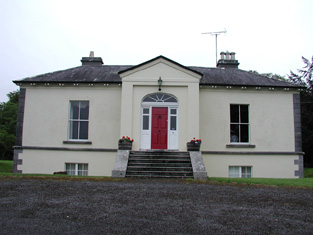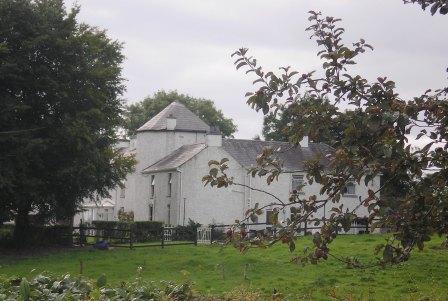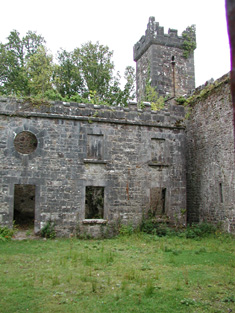Rockingham
Houses within 5km of this house
Displaying 20 houses.
Houses within 5km of Rockingham
Displaying 20 houses.
| House name | Description | |
|---|---|---|
| Ardcarne House | At the time of Griffith's Valuation John Hackett was leasing Ardcarne House, valued at £25, from Viscount Lorton's estate. The house is still extant and used as a farmhouse. |

|
| Glencarne House | At the time of Griffith's Valuation Samuel Handy was leasing a house valued at £18 at Ardcarne, barony of Boyle, from Viscount Lorton's estate. Glencarne is now a guesthouse. |

|
| Castle Island | Also known locally as the Rock of Lough Key, at the time of Griffith's Valuation Viscount Lorton's estate owned a house on Castle Island valued at £14. The original building on the island was a medieval stronghold of the McDermott family to which additions were made in the early 19th century. Renovation work was taking place on these buildings in 2007. |

|
| Ardcarn Glebe | At the time of Griffith's Valuation Viscount Lorton was leasing the Glebe House in Ardcarn parish to Rev. George Griffith when it was valued at £12. It is still extant and is part of a large farming enterprise. |

|
| Grevisk | At the time of Griffith's Valuation Thomas Phibbs Peyton was leasing a house at Grevisk, valued at £10, along with 100 acres, from Viscount Lorton's estate. The Census of 1749 recorded Grevisk as the home of John Nesbit. It is still extant. | |
| Knockvicar | At the time of Griffith's Valuation Charles J. Peyton was leasing a house at Knockvicar, parish of Ardcarn, valued at £15 to Edward Jones. Lewis records the house as the seat of C.J. Peyton in 1837. In 1814 it was the seat of Randal Peyton. | |
| Oakport | Oakport was the home of the Reverend William French, fourth son of John French of French Park, in the early 18th century. At the time of Griffith's Valuation, Oakport House, the property of Thomas William Goff, is recorded as "unoccupied". A house is still extant at the site. | |
| Mount Erris | At the time of Griffith's Valuation William Duckworth was leasing this house valued at £26 from Viscount Lorton's estate. There is still an inhabited house at this site. |

|
| Tangier | Caleb Robertson is recorded as occupying the house known at the time of the first Ordnance Survey. He is noted as the immediate lessor at the time of Griffith's Valuation though the house was unocciped and valued at £28. Tangier House was occupied by Harward O'Farrell, a doctor, in the second half of the 19th century. His third son, Sir George Plunkett O'Farrell, was granted arms in 1909. A house is still extant at the site. | |
| The Warren | Caleb Robertson is recorded as the lessor of a property in the townland of Warren or Drum at the time of Griffith's Valuation. It was valued at £25 and leased to a Captain Butler. A house at this site is labelled The Warren on the 25-inch map of the 1890s and a house still exists there. | |
| King House | King House was built between 1720-1740 by Sir Henry King. In 1786 Wilson wrote "the Earl of Kingston has a very fine house at Boyle, situated near the ruoins of an ancient abbey". Following a fire in 1788 the King family vacated the house and moved to Rockingham on the shores of Lough Key. King House was used as a military barracks until the 1960s. It is now in the ownership of Roscommon County Council and is open to the public. |

|
| Lough Key House | At the time of Griffith's Valuation, Alicia Peyton was leasing a house valued at £13 at Ballykeevican, barony of Boyle, from Viscount Lorton's estate. This property is now Lough Key House guesthouse. |

|
| Carrickard House | At the time of Griffith's Valuation, Charles Peyton was leasing a house at Keeloges, valued at £25, from Lord Lorton's estate. |

|
| Riversdale House | John R. French was leasing a house valued at £25 at Kilateasheen from the Ecclesiastical Commissioners at the time of Griffith's Valuation. There is no substantial house marked on the 1st edition OS map. This house is still extant and known as Riversdale House. |

|
| Woodbrook House | Keenehan and others state that Woodbrook House was built around 1780 by the Phibbs family although there may have been an earlier house on the site. The Kirkwood family purchased the property sometime in the early nineteenth century. At the time of Griffith's Valuation Sarah Mary Kirkwood was leasing a house at Usna, barony of Boyle, valued at £14, from Robert H. Brewster French. From the 1890s-1911 Woodbrook was a very successful racing stables run by Colonel Tom Kirkwood. Life in the house in the post-WWI era has been made famous by the memoir ''Woodbrook'' written by the Scottish author David Thomson, a tutor to the daughters of the family. In 1946 over 50 acres of the estate was sold to the local golf club while the Land Commission subsequently divided the remainder. Woodbrook House is still extant. | |
| Ellesmere | Harloe Powell was leasing a house valued at £18 at Ardcarn, barony of Boyle, from Viscount Lorton's estate, at the time of Griffith's Valuation. This house is still extant and occupied. |

|
| Abbey View House | Morgan Crofton, agent to Lord Lorton, was residing here at the time of the first Ordnance Survey. At the time of Griffith's Valuation it was occupied by Caleb Robertson and valued at £34. A house is still extant at Abbey View. |

|
| Coote Hall | In the seventeenth and eighteenth centuries Coote Hall was owned by the Coote family. The 4th and 5th Baronets, both named Charles, lived there and it was one of the houses O'Carolan visited and for whom he composed tunes. It was bought by Maurice O'Conor in the 18th century and later again by the Barton family. There is still an extant house at the site. |

|
| Drum Lodge | One of the many surviving gatelodges on the Rockingham Demesne. |

|
| Cloontykilla Castle | This building was constructed after the publication of the first Ordnance Survey Map. It appears to have functioned as a shooting/fishing lodge for the King estate. It is now a ruin. |

|

